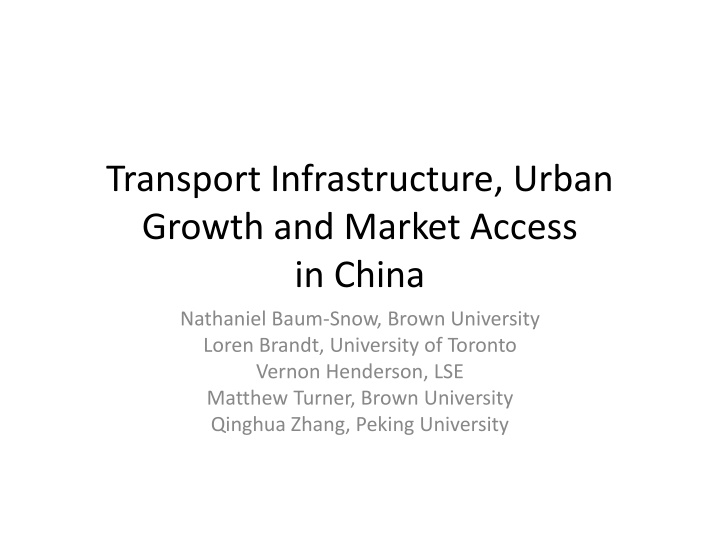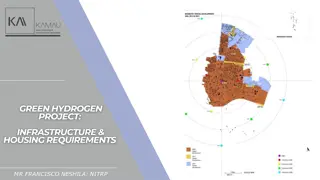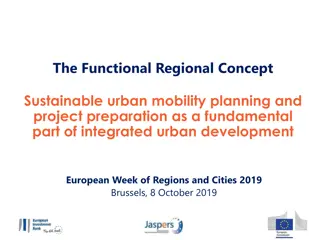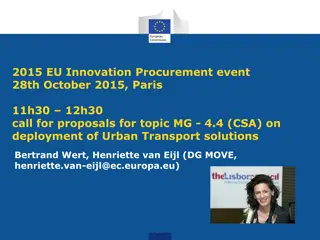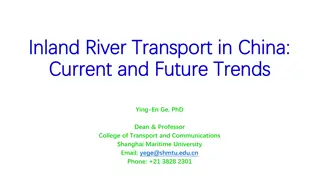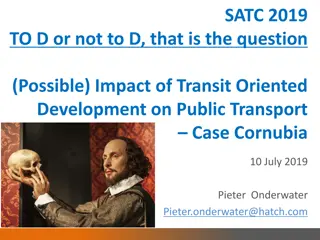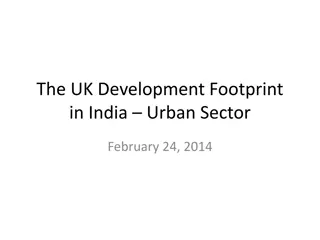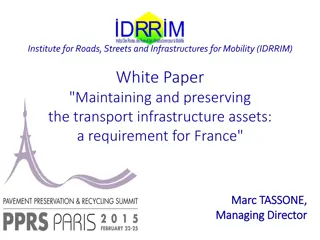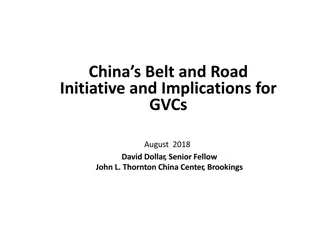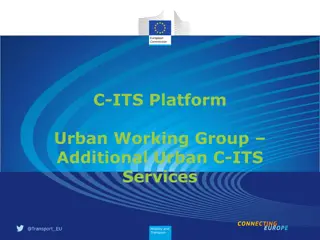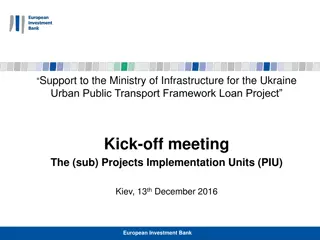Impact of Transport Infrastructure on Urban Growth and Market Access in China
Examining the effects of new highways and railroads on urban growth in Chinese prefectures and cities, this study investigates mechanisms internal to cities, such as improved market access. It delves into the influences on growth versus redistribution and highlights the motivations behind massive investments in transport infrastructure. Preliminary findings show varying impacts on GDP and population growth, shedding light on the complex dynamics of urban development in relation to transportation networks.
Download Presentation

Please find below an Image/Link to download the presentation.
The content on the website is provided AS IS for your information and personal use only. It may not be sold, licensed, or shared on other websites without obtaining consent from the author.If you encounter any issues during the download, it is possible that the publisher has removed the file from their server.
You are allowed to download the files provided on this website for personal or commercial use, subject to the condition that they are used lawfully. All files are the property of their respective owners.
The content on the website is provided AS IS for your information and personal use only. It may not be sold, licensed, or shared on other websites without obtaining consent from the author.
E N D
Presentation Transcript
Transport Infrastructure, Urban Growth and Market Access in China Nathaniel Baum-Snow, Brown University Loren Brandt, University of Toronto Vernon Henderson, LSE Matthew Turner, Brown University Qinghua Zhang, Peking University
Questions of Interest How have new highways and railroads influenced urban growth in Chinese prefectures and cities? Mechanisms internal to cities Improved access to domestic markets Improved access to international markets To what extent are these influences reflected in growth versus redistribution?
Motivations Important Policy Questions Developing countries are making huge investments in highways and railroads - about $200 billion per year in China since 1990 The impacts of new transport infrastructure in developing country contexts are just starting to receive serious research attention About 20% of World Bank lending is for transport infrastructure Little is known about the relative importance of various classes of mechanisms through which transport infrastructure may drive urban growth New highways typically influence internal city transport costs, those between cities and international transport costs simultaneously
Potential Channels Mechanisms internal to cities Free up low agglomeration spillover land intensive activities to decentralize Enhance agglomeration spillovers across firms conditional on locations Lower cost access to shared intermediate inputs Easier flow of ideas across firms Allow cities to accommodate greater population, thereby enhancing their productivity through agglomeration economies Improved access to domestic markets and international markets Ricardian gains from trade Knowledge spillovers Innovation through tougher competition Promote structural change
Preview of Results New highways promoted more GDP growth in prefectures that became better connected to more populous and prosperous domestic regions We find less robust commensurate effects for population New highways promoted population growth in prefectures that became better connected to international ports Because we find no commensurate effects for GDP, most of this looks like redistribution rather than growth Still represents welfare gains for many people because of higher GDP levels in regions with improved port access Radial railroads serving prefecture cities promoted population growth but not statistically significant GDP growth Once again, looks like welfare enhancing population redistribution
Relationship to the Literature A burgeoning literature investigates effects of transportation on regional growth in developing countries Alder (2014), Banerjee, Duflo & Qian (2014), Bosker (2014), Donaldson (2014), Donaldson & Hornbeck (2014), Faber (2014), Fajgelbaum & Redding (2014), Ghani, Goswami & Kerr (2014), Storeygard (2013) Another literature examines how within city transport infrastructure improvements can promote urban growth Duranton & Turner (2012), Baum-Snow (2014), Baum-Snow et al. (2014) This is the first study to examine both classes of explanations simultaneously, and with a new identification strategy
Context Our primary analysis starts in 1990: China is still a planned economy, except for a small amount of within-prefecture free trade in agriculture Inter-prefecture trade proscribed by provincial authorities Almost all inter-prefecture shipments by rail, mostly between prefecture cities and the provincial capitals Mostly unpaved roads used only for within-prefecture transport of agricultural goods from farms and manufacturing goods to farms By 2010: Largely a free market economy, with land and trade flows allocated by the market Largely complete national express highway system
Trends in Outcomes of Interest Change 1990-2010 1962/1982 1990 2010 Prefecture Level Outcomes log GDP 3.8 (0.8) 14.9 (0.6) 6.8 (0.9) 15.1 (0.7) 3.04 (0.43) 0.13 (0.20) log Population 14.8 (0.7) 2010 Definition Prefecture City Outcomes log GDP 2.7 (1.1) 13.5 (0.8) 5.9 (1.2) 13.9 (0.8) 3.20 (0.56) 0.35 (0.27) log Population 13.4 (0.8) Very rapid GDP growth everywhere Despite relative per-capita GDP in rural versus urban areas of 2.4 in 1990 and 2.1 in 2010, only 38% of the population lives in prefecture cities Hukou migration restrictions are an important element of the context
Expansions in Transport Infrastructure Serving Cities Change 1990-2010 1962 1990 2010 Road Rays 2.0 (1.4) 1.1 (1.2) 2.9 (1.4) 1.5 (1.3) 3.8 (2.0) 1.8 (1.3) 3.8 (2.0) 0.3 (1.1) Rail Rays
Measures of Explanatory Variables Intuitive variants of Market Potential based on Fujita, Krugman & Venables (1999) GDP within 6 hours by road (excluding own prefecture) Employment within 6 hours by road (excluding own prefecture) Travel time to the nearest international port GDP and employment variants of Market Access based on Eaton & Kortum (2002) and Hornbeck & Donaldson (2014) Smooth measure of connection to other markets that incorporates recursion and transitivity of linkages between regions Domestic component International component Radial highways and railroads serving prefecture cities
Correlation Across 2010 MP and MA Measures Market Potential GDP Market Access Pop Market Access q = 5 r = 0.2 q = 1.5 r = 0.02 r = 0.02 q = 5 q = 5 r = 0.2 q = 1.5 r = 0.02 r = 0.02 q = 5 Exp or GDP Emp Measure Used for Analysis Market Potential, GDP Market Potential, Employment GDP Market Access, q=1.5, r=0.2 Pop Market Access, q=1.5, r=0.2 1.00 0.93 0.41 0.35 0.93 1.00 0.43 0.41 0.69 0.72 0.86 0.83 0.14 0.15 0.93 0.93 0.20 0.22 0.96 0.95 0.57 0.68 0.84 0.87 0.12 0.15 0.93 0.93 0.18 0.21 0.95 0.96 All MA measures mutually highly correlated MA and MP measures are capturing something somewhat different
Population MP and MA Market Potential Market Access
Population MP and MA Market Potential Market Access
Population MP and MA Market Potential Market Access
Growth of MP and MA Change 1990-2010 1990 2010 Average prefecture GDP growth of 3.0 log points Market Potential Measures log GDP Within 6 Hours 4.7 (1.2) 15.65 (1.3) 7.16 (1.5) 9.9 (1.3) 17.29 (1.2) 5.9 (1.3) 5.3 (0.9) 2.01 (0.7) -1.3 (0.4) Average prefecture population growth of 0.13 log points log Employment Within 6 Hours (millions) log Road Time to Nearest Port Versions of MA and MP built using 2010 roads and 1990 quantities are quite similar to 2010 numbers Market Access Measures log Total Market Access (GDP) log Domestic Market Access (GDP) log External Market Access (GDP) log Total Market Access (Population) log Domestic Market Access (Population) log External Market Access (Population) 4.78 (0.17) 4.59 (0.17) 3.01 (0.21) 7.66 (0.15) 7.66 (0.15) -0.02 (0.21) 6.56 (0.16) 6.27 (0.16) 5.17 (0.18) 7.81 (0.14) 7.80 (0.14) 3.66 (0.18) 1.78 (0.06) 1.68 (0.06) 2.16 (0.09) 0.15 (0.06) 0.14 (0.06) 3.68 (0.09) Therefore, most of the MP and MA growth is from improvements in the road system
Empirical Strategy Think about a world with no trade and no highways in 1990, but some unobservables about prefectures that influence growth but are fixed over time This implies estimating coefficients in a regression equation like the following: = + + + + + y a a R b A b E CX v 0 1 1 2 t i it it it i it pre- determined control variables population or GDP growth rate radial highways and railroads serving prefecture city access to domestic markets access to international markets Still a potential problem of unobservables (not in X) correlated with R, A and E that drive growth
Identification Challenges Highways built to serve growing cities Highways built to connect more productive or export oriented cities Unobservables that drive regional growth also predict modern highway construction Cities with more railroads have more industry
Instruments 2010 radial highways and railroads serving prefecture cities 1962 radial roads and railroads serving prefecture cities Measures of market potential and market access along the 2010 road and highway network 1962 roads and the 5-7 Plan interacted with 1982 expenditure or 1982 employment Road travel time to nearest port 1962 roads and 5-7 Plan travel time to nearest port International market access External market access along 1962 roads and the 5-7 Plan with 1990 exports
Instrument Validity 1962 roads Existence of these rights of way made subsequent highway construction less costly Less than half of such roads were even passable by truck, and the ones that were passable had top speeds of about 25 kph Mostly unpaved and existed almost exclusively for local transport of agricultural goods Controls for variables correlated with the amount of prefecture agricultural activity are therefore crucial 1962 railroads Existed for shipping manufactures and agricultural products mostly between prefecture cities and provincial capitals 5-7 Plan Developed in the early 1980s to link 38 nodal prefecture cities in our study area Idea is to look at cities in between which ultimately got linked into the network only for this reason
Sources of Identifying Variation Compare prefectures receiving more limited access highways between 1990 and 2010 because of having had more unimproved roads serving the city in 1962 relative to those with fewer unimproved roads in 1962 Compare prefectures better linked to larger cities because they were intermediate locations on the 5-7 Plan or central in the 1962 road network to others Compare prefectures better linked to international ports because they were intermediate locations on the 5-7 Plan or central in the 1962 road network to others not linked well to ports on these networks All of these are comparisons conditional on controls for provincial capital indicators 1982 prefecture population 1982 prefecture industry mix 1982 prefecture education distance to the coast
Population MP and MA Market Potential Market Access
Instruments for Population MP and MA uses 1962 road network+5-7 plan and 1982 employment or population Market Potential Market Access
First Stage Results Highways, Railroads and MP log 2010 Time to Nearest Port 0.03 (0.02) -0.03 (0.02) 0.00*** (0.00) log 2010 GDP Within 6 Hours -0.06 (0.04) -0.07 (0.04) 0.71*** (0.07) log 2010 Emp Within 6 Hours -0.06* (0.03) -0.07* (0.04) Road Rays 0.35*** (0.07) 0.18* (0.09) -0.00** (0.00) Rail Rays -0.01 (0.05) 0.33*** (0.07) 0.00 (0.00) 1962 Road Rays 1962 Rail Rays log 1962/1982 Expend. Market Potential log 1962/1982 Emp. Market Potential log 1962 Time to Nearest Port Provincial Capital ln 1982 Prefec Pop 1982 Fraction HS Graduate 1982 Fraction Manufacturing log km to Coast 0.69*** (0.07) 0.07* (0.04) -0.69*** (0.15) 0.35*** (0.08) 4.36*** (1.28) -0.86 (0.58) -0.06** (0.03) 1.03 (1.77) 0.60 -0.24* (0.12) 1.74*** (0.50) 0.74*** (0.17) 4.17 (2.66) -3.07* (1.61) 0.17*** (0.06) -7.48*** (2.64) 0.33 -0.14** (0.06) 0.03 (0.26) 0.37*** (0.11) 4.56** (1.77) -1.35 (0.89) 0.12*** (0.04) -4.16** (1.66) 0.27 0.05 (0.04) -0.93*** (0.18) 0.38*** (0.09) 5.22*** (1.60) -0.19 (0.63) -0.11*** (0.03) -11.32*** (2.17) 0.56 0.88*** (0.03) 0.22*** (0.08) -0.07** (0.04) -2.11*** (0.63) 0.41 (0.33) 0.09*** (0.02) 0.99* (0.57) 0.92 Constant R-squared
First Stage Results Market Access log 2010 GDP Dom. Market Access 0.00 (0.01) 0.00 (0.00) log 2010 GDP Trade Market Access 0.00 (0.01) 0.00 (0.00) log 2010 Pop Dom. Market Access 0.00 (0.01) 0.00 (0.00) log 2010 Pop Trade Market Access 0.00 (0.01) 0.00 (0.00) log 2010 GDP Market Access 0.00 (0.01) 0.00 (0.00) 0.21** (0.10) log 2010 Pop Market Access 0.00 (0.01) 0.00 (0.00) 0.24*** (0.09) 1962 Road Rays 1962 Rail Rays 1962/1982 log Full Market Access 1962/1982 log Dom. Market Access 1962/1982 log Trade Market Access Provincial Capital ln 1982 Prefec Pop 1982 Fraction HS Graduate 1982 Fraction Manufacturing log km to Coast 0.26 (0.21) -0.02 (0.18) -0.03 (0.02) 0.04 (0.03) 0.55 (0.48) -0.21 (0.20) 0.01 (0.01) 2.03 (3.49) 0.07 -0.69*** (0.26) 0.80*** (0.23) -0.03 (0.02) 0.04 (0.03) 0.64 (0.57) -0.26 (0.23) 0.01 (0.01) 17.66*** (4.27) 0.06 0.38** (0.17) -0.13 (0.15) -0.03 (0.02) 0.04 (0.02) 0.49 (0.43) -0.20 (0.18) 0.01 (0.01) 4.28*** (1.17) 0.07 -0.63*** (0.23) 0.73*** (0.21) -0.03 (0.02) 0.04 (0.03) 0.65 (0.57) -0.26 (0.23) 0.01 (0.01) 7.64*** (1.57) 0.06 -0.03 (0.02) 0.04 (0.03) 0.61 (0.50) -0.21 (0.20) 0.01 (0.01) 3.13*** (0.83) 0.06 -0.02 (0.02) 0.04 (0.02) 0.46 (0.43) -0.21 (0.18) 0.01 (0.01) 5.33*** (0.37) 0.07 Constant R-squared MA instruments are a bit weak, especially for domestic and international components
Main Outcomes of Interest Prefecture and prefecture city GDP growth Prefecture and prefecture city population growth Important to take into account that hukou migration restrictions makes it unlikely to find migration effects
Results for Prefecture GDP Outcome(s) of Inquiry: Road Rays Internal Transport GDP Market Potential Employment Market Potential 0.056 (0.048) Rail Rays log 2010 Market Potential log 2010 Time to Coast Provincial Capital ln 1982 Prefec Pop 1982 Fraction HS Graduate 1982 Fraction Manufacturing log km to Coast 0.053 (0.060) 0.13*** (0.033) 0.12*** (0.033) -0.021 (0.025) 0.36*** (0.077) 0.11*** (0.044) -0.021 (0.063) 0.26 (0.35) -0.13** (0.049) 0.015 (0.75) 0.34 (0.40) 0.17*** (0.036) 0.17*** (0.037) -0.016 (0.024) 0.32*** (0.076) 0.17*** (0.044) -0.0069 (0.055) 0.28 (0.30) 0.15 (0.12) -0.043 (0.065) -0.33 (0.73) 0.76** (0.36) -0.088*** -0.085*** -0.053*** -0.047*** -0.045* -0.060*** -0.054*** -0.053** (0.018) (0.019) (0.015) (0.017) 3.88*** 3.62*** 3.93*** 4.12*** (0.91) (0.91) (0.58) (0.67) No No No No 20.5 28.7 146 69.4 0.24*** (0.082) -0.018 (0.060) -0.42 (0.87) 0.60* (0.34) 0.36*** (0.077) -0.13*** -0.13*** (0.043) -0.30 (0.63) 0.32 (0.33) 0.32*** (0.075) -0.13*** -0.13*** -0.13*** (0.042) (0.041) -0.13 -0.16 (0.63) (0.64) 0.44 0.38 (0.32) (0.33) (0.042) -0.36 (0.65) 0.27 (0.34) (0.047) 0.25 (0.74) 0.42 (0.38) (0.024) 4.06*** (0.84) Yes 45.7 (0.014) 2.28*** (0.67) No 105 (0.017) 2.45*** (0.79) No 53.1 (0.025) 2.33** (0.98) Yes 40.8 Constant Exlude 5-7 Nodes First Stage F Estimated effects of market access are consistent with those of market potential Results for prefecture cities are also similar, though a bit smaller in magnitude
Results for Prefecture Population Outcome(s) of Inquiry: Road Rays Internal Transport GDP Market Potential Employment Market Potential 0.0041 (0.022) Rail Rays log 2010 Market Potential log 2010 Time to Coast Provincial Capital ln 1982 Prefec Pop 1982 Fraction HS Graduate 1982 Fraction Manufacturing log km to Coast 0.065** (0.032) 0.030 (0.022) 0.0060 (0.013) -0.064** (0.027) 0.28*** (0.041) -0.029 (0.019) -0.098* (0.050) 0.074 (0.27) 0.038* (0.021) 0.015 (0.013) -0.062** -0.085** (0.027) 0.28*** (0.039) -0.016 (0.017) (0.043) 0.16 (0.22) 0.24*** (0.040) -0.087** -0.12*** -0.11*** -0.12*** -0.049*** -0.12*** -0.12*** -0.056*** (0.043) (0.040) (0.043) (0.036) -0.011 -0.47 -0.045 -0.25 (0.24) (0.33) (0.26) (0.23) 0.30* 0.28 0.22 0.089 (0.17) (0.18) (0.19) (0.21) -0.035*** -0.042*** -0.029*** -0.011 (0.012) (0.013) (0.0084) (0.0092) 1.55** 2.01*** 1.62*** 2.25*** (0.64) (0.63) (0.49) (0.60) No No No No 20.5 28.7 146 69.4 0.24*** (0.040) 0.27*** (0.045) 0.27*** (0.040) (0.015) -0.37* (0.22) 0.28* (0.16) 0.0020 (0.0099) 1.71*** (0.47) Yes 45.7 (0.042) -0.0019 (0.26) 0.25 (0.18) -0.030*** (0.0088) 1.30*** (0.38) No 105 (0.036) -0.24 (0.23) 0.088 (0.20) -0.012 (0.0091) 2.09*** (0.56) No 53.1 (0.014) -0.42* (0.24) 0.23 (0.16) 0.0018 (0.0098) 1.72*** (0.52) Yes 40.8 Constant Exlude 5-7 Nodes First stage F Estimated effects of market access are consistent with those of market potential Results for prefecture cities are also similar, though a bit smaller in magnitude
Main Conclusions Expansions of highways and railroads in China have promoted regional and urban growth through mechanisms internal to cities and through improved trade integration Each radial railroad serving a prefecture city allowed it to accommodate an estimated 7.3 percent more population (6.5 percent more in the full prefecture) The estimated elasticity of prefecture GDP with respect to GDP market potential is 0.11 and with respect to employment market potential is 0.17 No similar effects for prefecture or city population The estimated elasticity of prefecture population with respect to travel time to an international port is about -0.08 No similar effects for prefecture or city GDP May be driven by special economic zones set up to promote foreign investment It is important to consider the extent to which these results imply increases in per- capita GDP versus its redistribution
